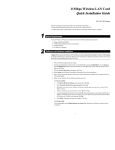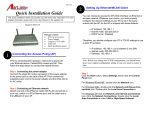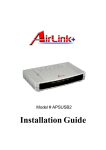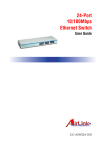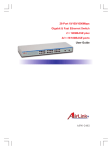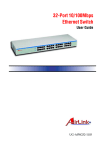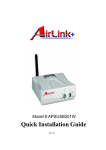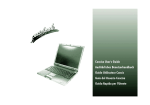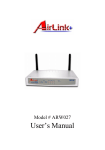Download Airlink AWLH3025 Network Card User Manual
Transcript
Model # AWLH3025 User’s Manual Ver. 1A REGULATORY STATEMENTS FCC Certification The United States Federal Communication Commission (FCC) and the Canadian Department of Communications have established certain rules governing the use of electronic equipment. Part15, Class B This device complies with Part 15 of FCC rules. Operation is subject to the following two conditions: 1) This device may not cause harmful interface, and 2) This device must accept any interface received, including interface that may cause undesired operation. This equipment has been tested and found to comply with the limits for a Class B digital device, pursuant to Part 15 of the FCC Rules. These limits are designed to provide reasonable protection against harmful interference in a residential installation. This equipment generates, uses and can radiate radio frequency energy, and if not installed and used in accordance with the instructions, may cause harmful interference to radio communications. However, there is no guarantee that interference will not occur in a particular installation. If this equipment does cause harmful interference to radio or television reception, which can be determined by turning off and on, the user is encouraged to try to correct the interference by one or more of the following measures: ◗ Reorient or relocate the receiving antenna. ◗ Increase the distance between the equipment and receiver. ◗ Connect the equipment into an outlet on a circuit different from that to which the receiver is connected. CAUTION: 1) To comply with FCC RF exposure compliance requirements, a separation distance of at least 20 cm must be maintained between the antenna of this device and all persons. 2) This transmitter must not be co-located or operating in conjunction with any other antenna or transmitter. Table of Contents INTRODUCTION...................................................................................... 1 WIRELESS NETWORK OPTIONS ................................................................. 1 The Peer-to-Peer Network............................................................ 1 The Access Point Network ........................................................... 2 LED INDICATORS ..................................................................................... 3 Power Indicator: (Orange LED) ................................................... 3 Act Indicator: (Green LED) ......................................................... 3 INSTALLATION ....................................................................................... 4 INSTALL THE DRIVER & UTILITY .............................................................. 4 INSTALL THE DEVICE................................................................................. 7 Note for Windows 98 users:......................................................... 7 Note for Windows 2000 users:..................................................... 7 Note for Windows XP users:........................................................ 8 Verify Device Installation .......................................................... 10 CONFIGURATION................................................................................. 11 ACCESSING THE CONFIGURATION UTILITY ............................................. 11 MAIN TAB ............................................................................................... 12 ADVANCED TAB ..................................................................................... 16 PRIVACY TAB ......................................................................................... 16 STATISTICS TAB ...................................................................................... 20 ABOUT TAB ............................................................................................ 21 UNINSTALLATION ............................................................................... 22 INTRODUCTION The 802.11g Wireless LAN Card is a device that allows you to connect your computer to a Wireless Local Area Network (WLAN). A wireless LAN allows your system to use wireless Radio Frequency (RF) technology to transmit and receive data without having to physically attach to the network. The wireless protocols that come with this product ensure data security and isolation from interference generated by other radio frequencies. This card also allows you to take full advantage of your computer’s mobility with access to real-time information and online services anytime and anywhere. In addition, this device eliminates the hassle of pulling cable through walls and under furniture. It even allows you to place your system in locations where cabling is impossible. Modifying and augmenting networks has never been so easy. Wireless Network Options The Peer-to-Peer Network (a.k.a. Ad-Hoc) This network installation lets you set a small wireless workgroup easily and quickly. Equipped with wireless PC Cards or wireless PCI cards, you can share files and printers between each PC and laptop. -1- You can also use one computer as an Internet Server to connect to a wired global network and share files and information with other computers via a wireless LAN. The Access Point Network (a.k.a. Infrastructure) The network installation allows you to share files, printers, and Internet access much more conveniently. With the Wireless LAN Card, you can connect wirelessly to a wired global network via an access point or wireless router. -2- LED Indicators For Wireless Network Adapter Card Power Indicator: (Green LED) This LED will illuminate when the driver is installed. Act Indicator: (Green LED) This LED flickers when transmitting/receiving data. the Wireless -3- Network Adapter is INSTALLATION Caution: Be sure to power off your computer before inserting the PCI adapter. Install the Driver & Utility Step 1 Insert the PCI adapter into an available PCI slot and turn on your computer. Step 2 Windows will detect the adapter and request for a driver. Click Cancel to quit the wizard and insert the Driver & Utility CD into your CD drive. Step 3 Select Install Driver & Utility from the setup menu. Note: If the setup menu does not appear automatically, click Start, Run, type D:\Setup.exe (where D is the letter of your CD drive) and click OK. -4- Step 4 When the welcome screen appears, click Next. Step 5 Click Next to accept the default destination folder to install the software or click Browse to manually select a different destination folder. Step 6 Click Next at the Select Program Folder screen. -5- Step 7 Remove the Driver & Utility CD from your CD drive and then click OK to restart your computer. -6- Install the device Note: Make sure the procedures in “Install the Driver & Utility” have been performed. In most cases, Windows will automatically install the driver after the computer is restarted, if the Found New Hardware Wizard appears, follow the steps below. Note for Windows 98 & ME users: Before installing the device, make sure you have your Windows 98 or ME CD at hand. You may be asked to insert the Windows 98 or ME CD in order to install specific files. Note for Windows 2000 users: During the installation, when the “Digital Signature Not Found” screen appears, click “Yes” to continue. -7- Note for Windows XP users: 1. Select Install the software automatically (Recommended) and click Next. -8- 3. Click Continue Anyway at the Windows Logo testing screen. 4. Click Finish to complete the installation. -9- Verify Device Installation To verify that the driver has been properly installed in your computer, go to Start Æ Settings Æ Control Panel Æ System (Æ Hardware) Æ Device Manager. Expand the Network adapters item. If the 802.11g Wireless Wireless Network Adapter PC Card is listed, it means that your device is properly installed and enabled. - 10 - CONFIGURATION After successfully installing the driver and utility, a Utility Icon will appear on the desktop. If the Utility Icon doesn’t appear automatically, go to Start Æ (All) Programs Æ WlanUtility Æ Wireless LAN Utility. Accessing the Configuration Utility The Configuration Utility is accessed by double-clicking on the Wireless LAN Utility Icon on the Desktop. All settings are categorized into 5 Tabs: Main Tab Advanced Tab Privacy Tab Statistics Tab About Tab - 11 - Main Tab The Main tab displays the current status of the Wireless Network Adapter. Item Description External Configuration Uncheck the box to use this utility to configure the wireless network adapter. Or check the box to use Windows XP’s Wireless Zero Configuration Utility. The SSID is the Network ID shared among all devices in your wireless network. The name must be identical for all devices to connect to the same network. No encryption SSID Encryption enabled For TI-Based WLAN For TI-Based WLAN with encryption - 12 - Item Description Mode Displays the type of connection: Access Point or Peer-to-Peer. Displays the channel that is currently in use. Ch Signal BBS ID Displays the signal strength of the connection between the Wireless Network Adapter and the Access Point it connects to. Displays the MAC address of the target device. Current Configuration Pref. SSID Shows the current SSID the wireless network adapter is connected to. BSS Type Shows the current connection type: Access Point or Peer to Peer. BSSID The MAC address of the device that the wireless network adapter is connected to. Channel Shows the current channel. Tx Rate Shows the current transfer rate. Signal Quality Shows the signal strength of the connection between the wireless network adapter and the device it connects to. Connect button Highlight one of the devices from the device list and press the Connect button to access it. There will be two tabs for you to modify, see the detailed information on next page. Searches all available networks. Clicking on this button, the wireless adapter will start to rescan and list all available devices. Modify button Rescan button - 13 - Preferred SSID BSS Type Tx Rate Channel Power Mode Type in the SSID of the target device you want to connect to. You can select the connection type: Peer-to-Peer, Access Point or Auto Mode. You can select the data rate or set to auto mode from the pull-down menu. Select the channel you want to use. No Power Save:the adapter will be in full active mode. Max Power Save:the power save mode will be enabled. Select to disable or enable the TI-Based 4x function. 4x Config Tx Power Select the transmit power level: Low Power, Medium-Low Power, Medium Power, Medium-High Power, High Power. The power Level level function is used to extend the communication distance. Select from 802.11b, 802.11b+, 802.11g, or B&G Mode (If you Mode choose this option the wireless network adapter will automatically select the suitable standard). Profile Enter the profile name and click the Save button to save your configuration, To open the profiles you saved, select the profile from the pull-down menu and then click the Load button. - 14 - Fragment Threshold RTS Threshold Preamble Retry limits You can fragment the MSDU or MMPDU into smaller sizes to increasing the reliability of frame transmission. (The maximum value of 4096 means no fragmentation is needed). The throughput performance will decrease however. This value should remain at its default setting of 4096. Should you encounter inconsistent data flow, only minor modification of this value is recommended. A preamble is a signal used in wireless environment to synchronize the transmission timing, including Synchronization and Start frame delimiter. (Note: If you want to change the Preamble type to Long or Short, please check the settings of your access point or wireless router. You can set the number of retries if no acknowledgement appears from the receiving station. - 15 - Advanced Tab The Advanced tab displays the current status of the Wireless Network Adapter. Privacy Tab Use the Privacy Tab to configure your encryption settings. WEP encryption or WPA-PSK can be used to ensure the security of your wireless network. Highlight WEP and click on the Configure button. - 16 - Privacy Mode Choose either WEP or WPA mode and click Configure: (Note: CCX is not available for this adapter). WEP is a data security mechanism based on a 40 Bit (a.k.a. 64 Bit)/128 Bit/256 Bit shared key algorithm. WPA is more secure than WEP, and should be used if possible. - 17 - WEP Configuration Authentication Encryption 1-4 The authentication type defines ID verification and access privileges of roaming wireless network cards. You may choose from Open System, Shared Key, or Auto Switch. Open System: If your access point/wireless router is using "Open System" authentication, then the wireless adapter will need to be set to the same authentication type. Shared Key: Shared Key is when both the sender and the recipient share a secret key. Auto Switch: Select Auto Switch for the adapter to automatically select the appropriate authentication mode. WEP (Wired Equivalent Privacy) encryption can be used to ensure the security of your wireless network. Select one Key and Key Size then enter the appropriate key value in the Encryption field. Note: You must use the same Key #, Key Size, and Encryption Key on both the host and destination devices in order to establish a connection. KEY1 ~ KEY 4:You can specify up to 4 different - 18 - Key size keys, but only one can be used at a time. Encryption:Enter the key value in this field. A key of 10 hexadecimal characters (0-9, A-F) is required if a 40-bit (a.k.a. 64-bit) Key Size is selected. A key of 26 hexadecimal characters (0-9, A-F) is required if a 128-bit Key Size is selected. A key of 58 hexadecimal characters (0-9, A-F) is required if a 256-bit Key Size is selected. Select from 40-bit (a.k.a. 64-bit), 128-bit or 256-bit. WPA-PSK Configuration If your wireless router/access point supports WPA, you can choose to enable WPA. 1. Select WPA from the Privacy tab, highlight Preshared Key and click Configure. 2. Click on the Passphrase field and enter a passphrase for the WPA key. (Note: minimum passphrase key must be 8 characters and must match the WPA key on your wireless router/access point). 3. You can check on the Unmask check box to see the passphrase you’ve entered. 4. Click OK to submit the passphrase. - 19 - Statistics Tab The Statistics Tab displays any available statistics including Receive packets, Transmit packets, Association reject packets, Association timeout packets, Authentication reject packets, and Authentication timeout packets. - 20 - About Tab Click on the About tab to view basic version information about the OS Version, Utility Version, Driver Version, Firmware Version and EEPROM Version. - 21 - UNINSTALLATION If you need to uninstall the driver and utility, follow the steps below. (When you uninstall the utility, the driver will be uninstalled as well.) 1. Go to Start Æ (All) Programs Æ WlanUtility Æ Uninstall Wireless LAN Utility. 2. Click OK to continue. 3. Select Yes, I want to restart my computer now, and then click Finish to complete the uninstalled procedure. - 22 - Appendix Technical Support E-mail: [email protected] Toll Free: 1-888-746-3238 Web Site: www.airlinkplus.com - 23 -



























